15 Poisonous Mushrooms Foragers Need to Know
- April 8, 2024
- 0 comment
Foraging into the wild for mushrooms requires not only a keen eye for edible varieties but also a deep awareness of their poisonous counterparts.
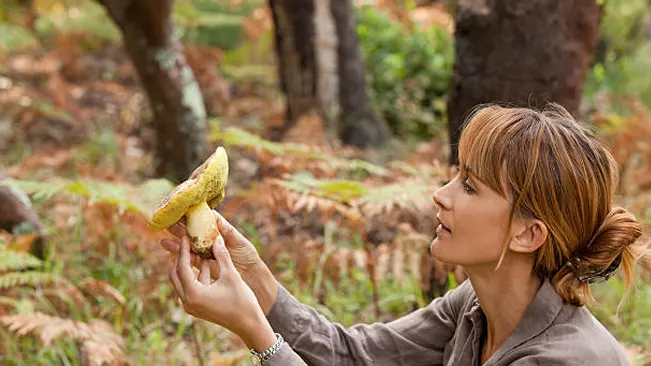
Among the 70-80 species of poisonous mushrooms, a few are fatally dangerous, posing a significant risk due to their uncanny resemblance to edible varieties. This deceptive similarity makes them particularly hazardous, as even experienced foragers can sometimes mistake them for safe-to-eat species.
This guide sheds light on 15 poisonous wild mushrooms, emphasizing the importance of accurate identification and the inherent dangers that lurk in misjudging these deceptive fungi.
List of 15 Poisonous Mushrooms Foragers Need to Know
- Death Cap (Amanita phalloides)
- Destroying Angel (Amanita virosa)
- False Morels (Gyromitra spp.)
- Fly Agaric (Amanita muscaria)
- Deadly Galerina (Galerina marginata)
- Autumn Skullcap (Galerina autumnalis)
- Jack O’Lantern Mushroom (Omphalotus olearius):
- Green-spored Lepiota (Chlorophyllum molybdites):
- Webcaps (Cortinarius spp.)
- Podostroma (cornu-damae)
- Fool’s Mushroom (Amanita verna)
- Panther Cap (Amanita pantherina)
- Ivory Funnel (Clitocybe dealbata)
- Angel Wings (Pleurocybella porrigens)
- Conocybe filaris
Different Varieties of Poisonous Wild Mushrooms
1. Death Cap (Amanita phalloides)
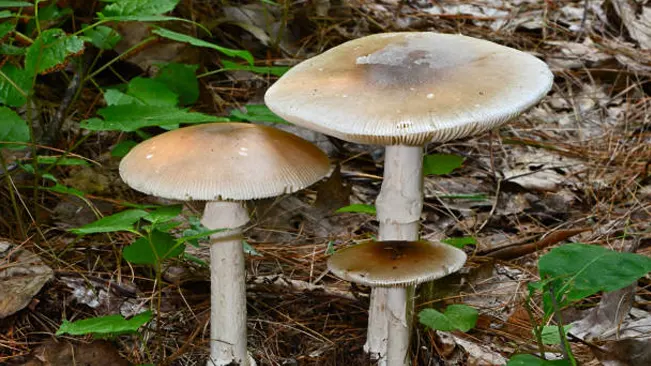
Notorious for its lethal toxicity and is often mistaken for edible species due to its unassuming appearance, featuring a pale to greenish cap, white gills, and a bulbous base. Thriving in both deciduous and coniferous forests, it forms mycorrhizal associations with various trees, making foraging in these areas particularly risky; accurate identification is imperative as ingestion can lead to severe poisoning and is often fatal.
Characteristics
- Appearance: Typically a medium to large mushroom with a distinctive appearance.
- Cap: The cap is 5-15 cm wide, initially bell-shaped before flattening with age. It can be greenish, yellowish, white, or brown, and often has a silky sheen.
- Gills: The gills are free from the stem, white, and quite crowded.
- Stem: It has a long, white stem (8-15 cm) with a bulbous base. A prominent ring (annulus) and a sac-like structure (volva) at the base are key identifying features.
- Habitat: Prefers deciduous and coniferous forests, often found near oak trees. Common in Europe and North America, particularly in coastal regions.
- Toxicity: Highly poisonous, containing amatoxins responsible for severe liver and kidney damage, often fatal when ingested. There is no known antidote, making it one of the most dangerous mushrooms in the world.
2. Destroying Angel (Amanita virosa)
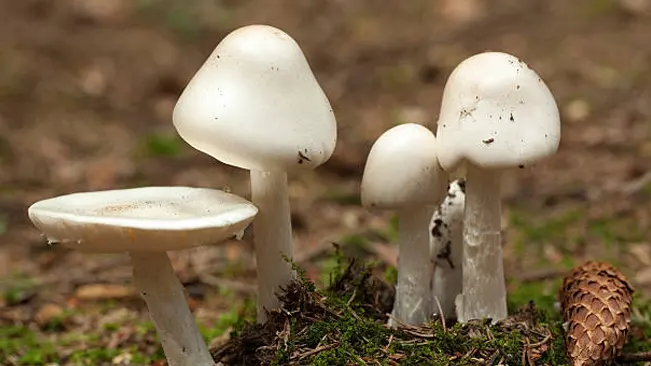
Dangerously poisonous and can be identified by its striking all-white appearance, including a smooth cap, gills, and stem, often with a ring and a bulbous base. It typically grows in woodland areas under a variety of trees, and its resemblance to edible mushrooms makes foraging particularly hazardous; even a small amount can cause severe poisoning, emphasizing the need for extreme caution and accurate identification.
Characteristics
- Appearance: A strikingly beautiful but deadly mushroom, often characterized by its elegant, pure white appearance.
- Cap: The cap is smooth and white, 5-10 cm in diameter, starting as egg-shaped before opening up to a convex or flat shape.
- Gills: The gills are free from the stem, very crowded, and white in color, matching the overall color of the mushroom.
- Stem: It features a long (up to 14 cm), slender, and white stem, with a prominent ring (annulus) and a bulbous base encased in a cup-like structure (volva).
- Habitat: Commonly found in woodlands and forests, particularly under coniferous and deciduous trees, across North America and Europe.
- Toxicity: Extremely poisonous, containing amatoxins that cause severe damage to the liver and kidneys, and often fatal if ingested. Symptoms of poisoning can be delayed, leading to a high risk of misdiagnosis.
3. False Morels (Gyromitra spp.)
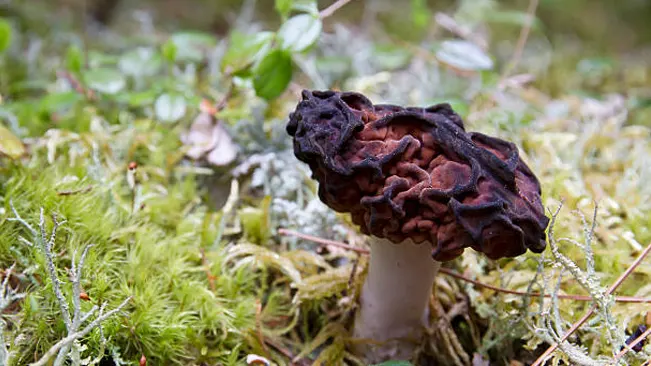
Notably toxic and can be identified by their irregular, brain-like or wrinkled caps, quite different from the honeycombed appearance of true morels. They are often found in forested areas, particularly under coniferous trees, in the springtime, and their deceptive resemblance to the highly sought-after true morels poses a significant risk for foragers. Consuming False Morels can lead to severe toxicity due to their gyromitrin content, underscoring the critical importance of cautious and knowledgeable mushroom identification.
Characteristics
- Appearance: Resemble true morels but are notably different upon closer inspection, often having a brain-like or wrinkled appearance.
- Cap: The cap is irregularly lobed, brain-like, or wrinkly, and varies in color from reddish-brown to dark brown. Unlike true morels, the cap is often attached to the stem at the top rather than at the base.
- Gills: False Morels don’t actually have gills; instead, the underside of their cap is smooth or wrinkled, not honeycombed like true morels.
- Stem: The stem is white to brown, typically thick and bulbous, which may be hollow or stuffed with a cottony material.
- Habitat: Commonly found in wooded areas, especially under conifers, as well as in sandy soils in spring to early summer.
- Toxicity: Contains gyromitrin, a toxic compound that is metabolized to monomethylhydrazine (MMH), which can cause severe liver and neurological toxicity, and in some cases, can be fatal. Cooking reduces but doesn’t eliminate the toxin, and its effects can accumulate in the body over time.
4. Fly Agaric (Amanita muscaria)

An iconic yet toxic mushroom, instantly recognizable by its bright red cap adorned with white spots. Commonly found in both coniferous and deciduous forests, it forms a symbiotic relationship with tree roots, making it a frequent sight in wooded areas. Despite its fairy-tale appearance, the Fly Agaric is psychoactive and poisonous, and its ingestion can lead to serious neurological and gastrointestinal symptoms, making it crucial for foragers to identify and avoid this alluring but dangerous fungus.
Characteristics
- Appearance: Iconic and easily recognizable, often depicted in folklore and fairy tales.
- Cap: The cap is 5-15 cm wide, bright red or orange with distinctive white warts (removable). It’s initially hemispherical before flattening with age.
- Gills: The gills are free from the stem, crowded, and white in color.
- Stem: Features a white stem, 5-20 cm tall, with a skirt-like ring and a bulbous base that typically has remnants of the universal veil, appearing as a white, ragged collar.
- Habitat: Common in coniferous and deciduous forests, often found near birch trees. Widely distributed in the Northern Hemisphere.
- Toxicity: Contains psychoactive compounds, including muscimol and ibotenic acid, which can cause hallucinations, delirium, and altered perception. While not typically fatal, consuming this mushroom can result in severe intoxication and should be avoided.
5. Deadly Galerina (Galerina marginata)
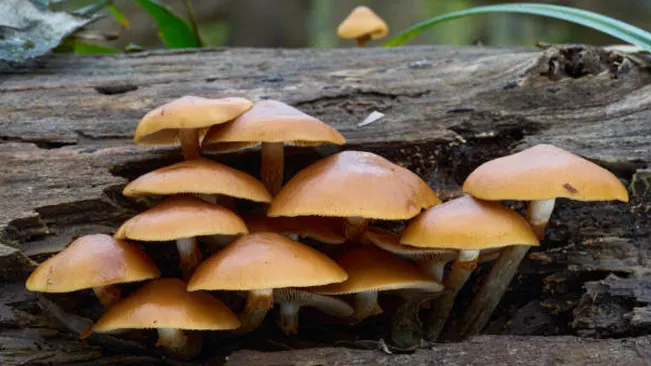
A small, unassuming mushroom with a bell-shaped, yellow-brown cap that flattens with age, often mistaken for non-toxic species. It grows on wood, particularly on logs and stumps in forests, and contains deadly amatoxins that can cause severe liver and kidney damage if ingested.
Characteristics
- Appearance: A small, unassuming mushroom, easily overlooked or mistaken for non-toxic species.
- Cap: The cap is typically 2-6 cm in diameter, initially bell-shaped, becoming broadly convex or nearly flat as it matures. The color varies from yellow-brown to rusty brown and often has a sticky or slimy texture when wet.
- Gills: The gills are attached to the stem, close together, and are initially pale, becoming rusty brown with age, matching the color of the spores.
- Stem: It’s slender (3-6 cm tall), with a similar color to the cap and features a ring (or remnants of one) that can be a key identifying feature. The base of the stem may be somewhat bulbous.
- Habitat: Commonly found growing on decaying conifer wood, including stumps, logs, and mulch, in forests or wooded areas. It can also grow in mixed woodlands and is widespread in temperate regions.
- Toxicity: Contains amatoxins, the same deadly compounds found in the more infamous Amanita species. Even small amounts can cause fatal liver and kidney damage. Poisoning symptoms can be delayed, leading to a greater risk of severe outcomes.
6. Autumn Skullcap (Galerina autumnalis)
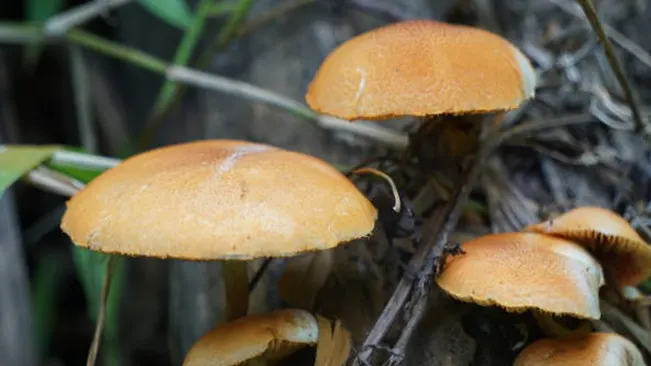
Presents as a small, deceptive mushroom with a brown, bell-shaped cap that turns rusty-brown as it ages, often appearing on decaying wood in forest environments. Its slender stem, featuring a faint ring, and gills that change from light to rusty brown, contribute to its often-mistaken identity. High in deadly amatoxins, the Autumn Skullcap poses a severe risk of liver and kidney damage if ingested, making accurate identification crucial.
Characteristics
- Appearance: A small, often overlooked mushroom, bearing a resemblance to other brown-capped species.
- Cap: The cap is typically 2-5 cm in diameter, initially bell-shaped, later becoming convex to flat. Its color is brown to yellow-brown, often darker at the center and lighter towards the edges, with a smooth to slightly sticky texture.
- Gills: The gills are attached to the stem, close, and initially light in color, turning brown to rusty brown as the spores mature.
- Stem: The stem is slender, 3-8 cm tall, and brown, often with a paler top and a ring or ring zone, which is a distinctive feature.
- Habitat: Prefers growing on decaying wood, particularly hardwoods, and can be found in forests and wooded areas, often in groups or clusters. It’s a common species in temperate regions during the fall.
- Toxicity: Contains deadly amatoxins, just like the Death Cap and Destroying Angel. Ingestion leads to severe liver and kidney damage, and can be fatal without prompt and proper medical treatment. Symptoms of poisoning may be delayed, complicating diagnosis and treatment.
7. Jack O’Lantern Mushroom (Omphalotus olearius)
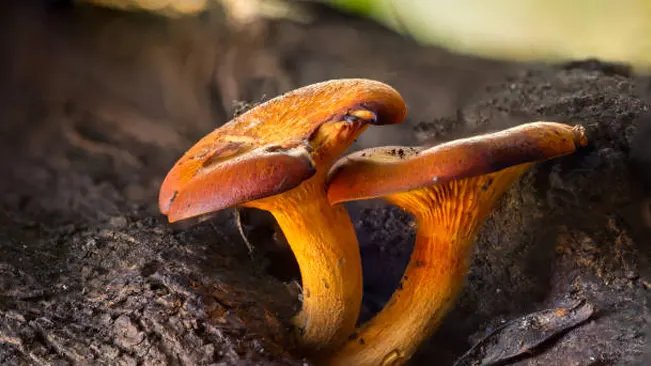
A toxic look-alike to the edible chanterelle, distinguished by its vibrant orange to yellow color and its growth in dense clusters on wood, particularly on stumps or buried roots. These mushrooms are commonly found in hardwood forests and can be misleading due to their resemblance to the sought-after chanterelles, but consuming them leads to severe gastrointestinal distress. Their bioluminescent properties, causing them to glow in the dark, provide a unique characteristic that aids in identification, yet foragers must exercise caution and precision to avoid mistaking these poisonous mushrooms for their edible counterparts.
Characteristics
- Appearance: Notable for its bright orange color, resembling a Halloween jack-o’-lantern.
- Cap: The cap ranges from 5 to 20 cm across, initially convex and then flattening out. The color is typically vibrant orange to yellow-orange, often with a smoother, shinier surface.
- Gills: The gills are distinctive for being bioluminescent, emitting a soft greenish glow in the dark. They are attached to the stem, densely packed, and the same bright color as the cap.
- Stem: The stem is thick, solid, and the same color as the cap. It can grow singly or have several stems fused at the base.
- Habitat: Commonly found growing in dense clusters on wood, particularly on stumps and roots of hardwood trees, in forests and wooded areas.
- Toxicity: While not deadly, it is poisonous and can cause severe gastrointestinal distress, including vomiting, diarrhea, and cramps. Its resemblance to edible chanterelles can lead to misidentification and accidental ingestion.
8. Green-spored Lepiota (Chlorophyllum molybdites)
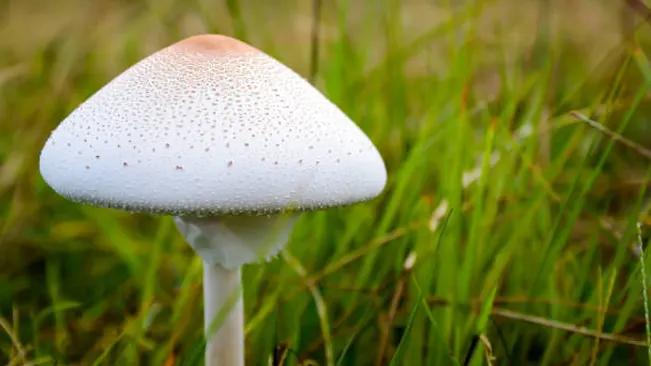
The Green-spored Lepiota, Chlorophyllum molybdites, is a common yet deceptive mushroom with a large, white or cream-colored, scaly cap, often mistaken for edible varieties. However, its green-spored print reveals its true nature as a highly toxic mushroom, known to cause severe gastrointestinal distress if ingested.
Characteristics
- Appearance: A large, conspicuous mushroom, often found in urban settings.
- Cap: The cap is broad, reaching 8-30 cm in diameter, initially rounded, then flattening with a raised center. It’s white to cream in color with brownish scales scattered across the surface.
- Gills: The gills are free from the stem, starting white but turning a distinctive greenish color as the spores mature, which is a key identification feature.
- Stem: The stem is tall and thick, up to 25 cm, with a bulbous base and a prominent, movable ring. The color is white, matching the cap.
- Habitat: Commonly found in lawns, gardens, and other grassy areas, especially where the ground has been disturbed. It’s one of the most common causes of mushroom poisoning in North America.
- Toxicity: Contains gastrointestinal irritants, causing severe stomach upset, vomiting, and diarrhea. While not usually deadly, its symptoms can be intense and require medical attention.
9. Webcaps (Cortinarius spp.)
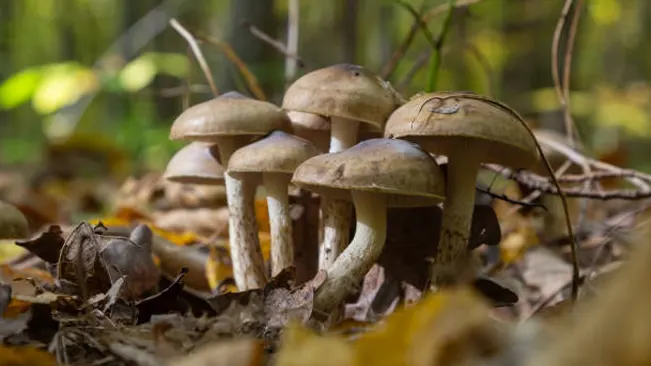
Webcaps, belonging to the Cortinarius genus, encompass a vast array of mushrooms, often characterized by their cobweb-like veil remnants and varying shades of brown or rust caps. Many species within this group contain dangerous toxins, with some being deadly, making accurate identification and avoidance crucial for foragers.
Characteristics
- Appearance: A diverse genus, Webcaps vary greatly in appearance, but many have a characteristic web-like veil (cortina) remnants on the stem.
- Cap: The cap sizes and shapes vary, but they often have a bell-shaped or convex cap that flattens with age. Colors range across various shades of brown, rust, and sometimes more vibrant colors in certain species.
- Gills: The gills are typically attached to the stem, starting out pale and turning rust-brown as the spores develop. This color change is a key characteristic of the genus.
- Stem: The stem can be slender to thick and is often adorned with the distinctive remnants of the cortina, a cobweb-like veil that covered the gills in young mushrooms.
- Habitat: Found in a variety of forested environments, both in coniferous and deciduous woods. Some species form mycorrhizal relationships with specific trees.
- Toxicity: Several species within this genus contain dangerous toxins, notably orellanine, which can cause severe kidney damage and potentially fatal renal failure. The toxicity can vary among species, but some are among the most poisonous mushrooms known. The effects of poisoning can take days or even weeks to appear, complicating diagnosis and treatment.
10. Podostroma (cornu-damae)
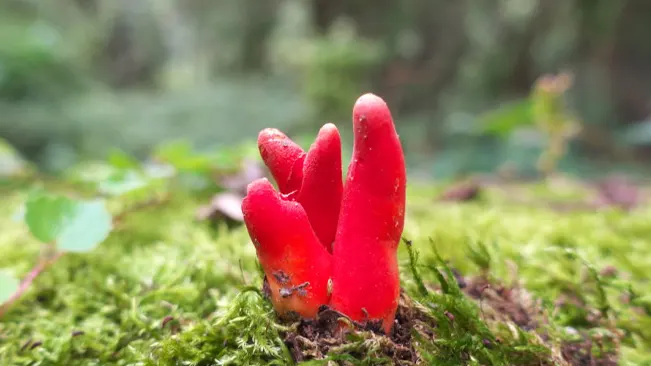
Podostroma cornu-damae, a rare but extremely toxic fungus, is recognized by its unusual, coral-like red fruiting bodies. Ingestion of even small amounts can lead to severe organ failure and death due to its potent trichothecene mycotoxins.
Characteristics
- Appearance: This rare fungus has a striking and unusual appearance, with its elongated, coral-like fruiting bodies.
- Cap: Unlike typical mushrooms, Podostroma cornu-damae lacks a traditional cap. Its fruiting bodies are composed of multiple, slender, finger-like projections.
- Gills: It does not have gills; instead, the spores are produced on the surface of the elongated, club-like structures.
- Stem: The stems are elongated, cylindrical, and can be variously branched, resembling a piece of coral or antlers.
- Habitat: Typically found growing on decaying wood in forests, particularly in Asia, including Japan and Korea. It often grows in clusters, emerging from wood debris.
- Toxicity: Extremely toxic, containing trichothecene mycotoxins, which can cause multiple organ failure, severe immune system suppression, and is often fatal if ingested. Symptoms of poisoning can include nausea, vomiting, diarrhea, low blood pressure, and eventual organ failure. Due to its high toxicity, even handling this fungus should be done with caution.
11. Fool’s Mushroom (Amanita verna)
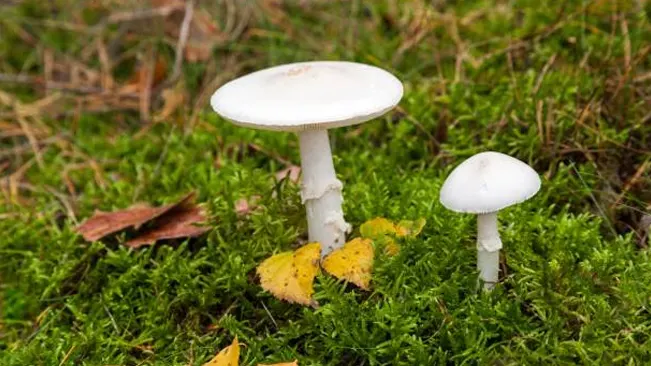
The Fool’s Mushroom, is a perilously toxic fungus, deceptively resembling edible white button mushrooms with its smooth, all-white appearance. This deadly species, containing the same lethal amatoxins as the notorious Death Cap, can cause fatal liver and kidney damage if consumed.
Characteristics
- Appearance: Resembles edible white mushrooms, which contributes to its dangerous nature.
- Cap: The cap is pure white, smooth, and usually 5-10 cm in diameter. It’s initially dome-shaped, becoming more flat as it matures.
- Gills: The gills are free from the stem, closely spaced, and are white in color, matching the cap and stem.
- Stem: Features a white, smooth, and slender stem, which includes a ring (annulus) and a bulbous base with a sack-like volva, characteristic of many Amanita species.
- Habitat: Common in woodlands and forests, often found under deciduous trees like oaks and beeches. It’s widely distributed across Europe and North America.
- Toxicity: Extremely poisonous, containing the same deadly amatoxins found in the Death Cap (Amanita phalloides). Ingestion can lead to severe liver and kidney damage, and without prompt medical treatment, it can be fatal. The mushroom’s resemblance to edible species makes it particularly dangerous.
12. Panther Cap (Amanita pantherina)
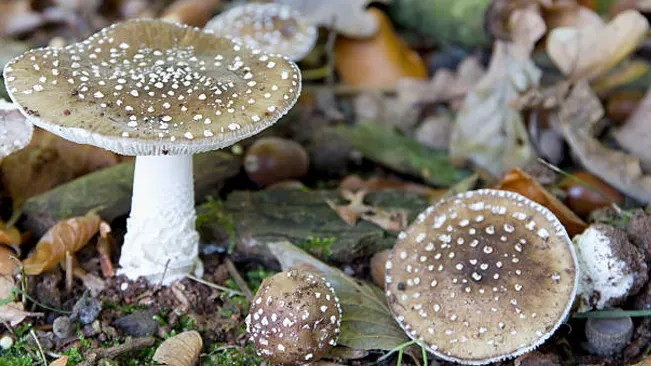
The Panther Cap is easily recognized by its brown cap with white spots and is notorious for its toxicity, similar to the infamous Fly Agaric. Containing psychoactive compounds, it causes hallucinations and neurological effects, making it a dangerous and misleading mushroom for foragers.
Characteristics
- Appearance: This attractive mushroom is known for its striking features and resemblance to some edible species.
- Cap: The cap is 5-12 cm in diameter, dome-shaped in young mushrooms, becoming flatter as it matures. It’s brown to dark brown, typically adorned with white to cream-colored warts or patches.
- Gills: The gills are white, free from the stem, and densely packed. They remain consistently white throughout the mushroom’s growth.
- Stem: Features a long, white stem (up to 15 cm tall) with a bulbous base. It includes a distinctive ring (annulus) and a volva at the base, typical of many Amanita species.
- Habitat: Found in both deciduous and coniferous forests, often under pine trees. Common across Europe and North America, particularly in temperate regions.
- Toxicity: Contains potent toxins, including ibotenic acid and muscimol, similar to Fly Agaric (Amanita muscaria). These compounds can cause hallucinations, confusion, and a range of other neurological symptoms. Ingestion can be dangerous and should be treated immediately.
13. Ivory Funnel (Clitocybe dealbata)
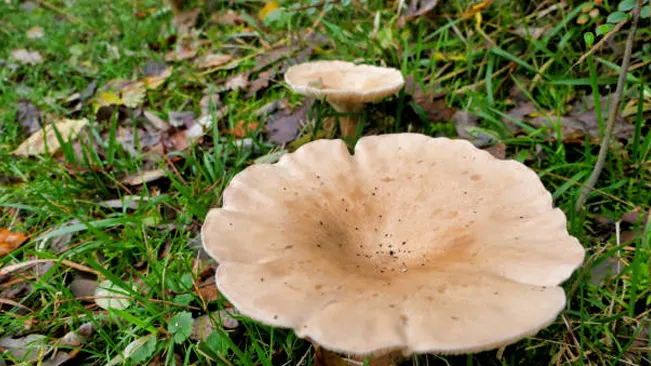
The Ivory Funnel, presents as a small, pale mushroom, often found in grassy areas, with a convex cap that flattens with age. Despite its unassuming appearance, it’s highly poisonous, containing muscarine that can cause severe respiratory distress and other nervous system effects if ingested.
Characteristics
- Appearance: A small and inconspicuous mushroom, often found in clusters.
- Cap: The cap is 2-6 cm in diameter, initially convex, then flattening with a slight depression in the center. It’s smooth and pale, ranging from white to ivory in color.
- Gills: The gills are attached to the stem, close together, and of the same color as the cap. As they age, they may become slightly yellowish.
- Stem: The stem is thin, cylindrical, and the same color as the cap. It can be 2-5 cm tall and often tapers towards the base.
- Habitat: Commonly found in grassy areas, lawns, and parks, particularly where the ground is rich in organic matter. It tends to grow in troops or rings.
- Toxicity: Contains muscarine, a toxic compound that affects the nervous system. Ingestion causes symptoms like excessive salivation, sweating, lacrimation, severe abdominal pain, and diarrhea. Though not typically fatal, its effects are unpleasant and require medical attention.
14. Angel Wings (Pleurocybella porrigens)
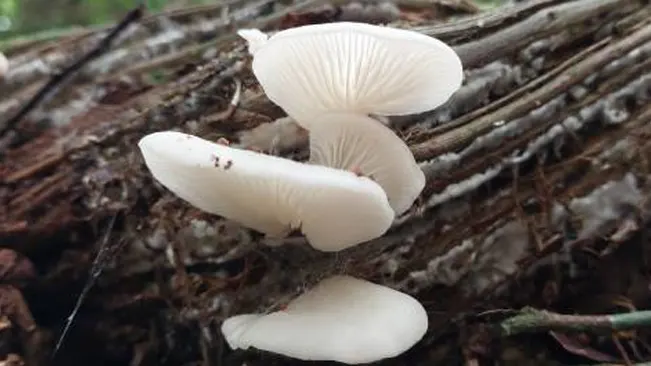
Angel Wings are distinguished by their thin, white, fan-shaped caps, commonly found on decaying conifer wood. Once considered edible, they are now treated with caution due to links to severe neurological disorders, particularly in individuals with pre-existing kidney conditions.
Characteristics
- Appearance: Thin and delicate, these mushrooms are notable for their angel wing-like shape.
- Cap: The cap is small to medium-sized, typically 2-10 cm wide, fan-shaped or kidney-shaped, and very thin. It’s white to pale gray in color, with a smooth surface and sometimes translucent edges.
- Gills: The gills run deeply down the stem (decurrent), are widely spaced, thin, and the same color as the cap.
- Stem: Quite short or almost absent, blending into the cap, and white in color.
- Habitat: Grows on decaying conifer wood, particularly on fallen logs and stumps in coniferous forests. It’s found in North America, Europe, and Asia, especially abundant in autumn.
- Toxicity: Previously considered edible, but after incidents in Japan of renal failure in patients with pre-existing kidney conditions, it’s now regarded with caution. Its toxicity may be linked to pre-existing health conditions, but it’s advisable to avoid consumption.
15. Conocybe filaris
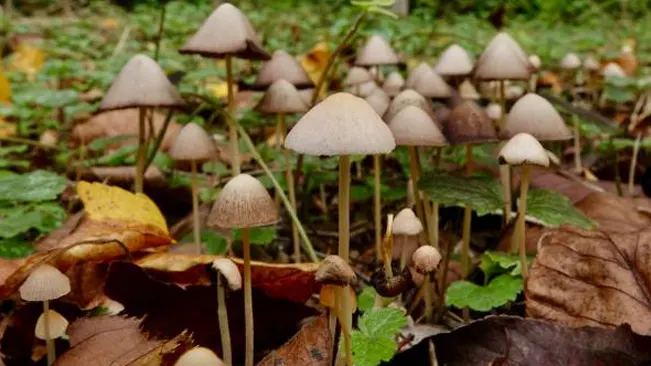
Conocybe filaris is a small, inconspicuous mushroom, often found in urban grassy areas, with a pale, conical cap and slender stem. Highly dangerous, it contains the same deadly amatoxins as more infamous Amanita species, causing severe liver and kidney damage upon ingestion.
Characteristics
- Appearance: A small and delicate mushroom, often overlooked due to its inconspicuous nature.
- Cap: The cap is typically 1-2.5 cm in diameter, conical to bell-shaped, and pale brown to cinnamon in color, often darker at the center. It dries out and flattens with age.
- Gills: The gills are attached to the stem or slightly free, crowded, and initially pale, turning a rusty brown color as the spores mature.
- Stem: It has a slender, long stem (up to 6 cm tall), which is smooth and the same color as the cap but may be slightly paler.
- Habitat: Common in lawns, gardens, and grassy areas, especially where the soil is rich in organic matter. It’s often found growing in small groups or singly.
- Toxicity: Highly poisonous, containing the same deadly amatoxins found in some Amanita species. Ingesting even a small amount can lead to severe liver and kidney damage, potentially resulting in death. Its common appearance in urban areas increases the risk of accidental poisoning.
Safety Reminder
- Positive Identification is Key: Never consume any wild mushroom unless it has been positively identified as edible by a knowledgeable expert. Many poisonous mushrooms closely resemble edible varieties.
- Avoid “Rule of Thumb” Methods: Disregard old wives’ tales or folklore methods for determining edibility, such as whether mushrooms can be consumed by animals or if they tarnish a silver spoon. These methods are myths and not reliable.
- Use Multiple Sources for Identification: Cross-reference mushrooms with multiple field guides or digital resources, and whenever possible, consult with experienced foragers or mycologists.
- Learn to Recognize Common Poisonous Species: Familiarize yourself with the most common poisonous mushrooms in your area, especially those that look similar to edible ones.
- When in Doubt, Throw It Out: If you’re uncertain about a mushroom’s species, it’s safer to err on the side of caution and not consume it. The risks of making a mistake can be severe, including fatal poisoning.
Conclusion
Wild mushrooms, while rich and diverse, harbors a significant risk with the presence of numerous poisonous varieties. These toxic species, ranging from the deceptively ordinary Conocybe filaris to the strikingly vibrant Fly Agaric, underscore the critical importance of accurate identification in foraging. Their potential for severe, sometimes fatal, health consequences serves as a stark reminder of the respect and caution necessary when interacting with nature’s fungal kingdom. For foragers and nature enthusiasts alike, knowledge and prudence are key to safely navigating and appreciating the intricate and often hidden dangers of wild mushrooms.
Frequently Asked Questions (FAQs)
- What makes the Death Cap (Amanita phalloides) so dangerous?
The Death Cap contains lethal toxins that cause liver and kidney failure, with symptoms often delayed, leading to a high risk of misdiagnosis and fatal outcomes. - How can I distinguish the Destroying Angel (Amanita virosa) from edible mushrooms?
The Destroying Angel is entirely white, with a smooth cap, white gills, a ring on the stem, and a bulbous base, but it closely resembles some edible species, making identification challenging. - Are False Morels (Gyromitra spp.) deadly, and how do they differ from true Morels?
Some False Morels contain deadly toxins that affect the liver and nervous system. They differ from true Morels by their brain-like or lobed cap, rather than the honeycomb pattern of true Morels. - Why is the Fly Agaric (Amanita muscaria) considered toxic if it’s not usually lethal?
The Fly Agaric contains psychoactive compounds causing hallucinations and confusion; while not typically fatal, its effects can be dangerous and unpredictable. - What are the symptoms of Deadly Galerina (Galerina marginata) poisoning?
Symptoms include severe abdominal pain, vomiting, diarrhea, liver failure, and potentially death, often resembling a severe case of food poisoning. - Can cooking make Autumn Skullcap (Galerina autumnalis) safe to eat?
No, cooking does not destroy the amatoxins present in Autumn Skullcap; it remains highly poisonous even after being cooked. - Why is the Green-spored Lepiota (Chlorophyllum molybdites) often mistaken for edible mushrooms? Its large, umbrella-like shape and white color resemble common edible mushrooms, but its green spore print is a distinguishing, though often overlooked, feature.
- What should I do if I accidentally touch or handle a poisonous mushroom like Conocybe filaris?
While touching poisonous mushrooms like Conocybe filaris is not harmful, you should wash your hands immediately and avoid touching your face or mouth. - Is the Ivory Funnel (Clitocybe dealbata) distinguishable from other white mushrooms in the wild?
The Ivory Funnel can be hard to distinguish due to its common white mushroom appearance; careful attention to its habitat and spore print is necessary. - Are Angel Wings (Pleurocybella porrigens) still considered edible?
Angel Wings were once thought to be edible, but recent incidents of toxicity, particularly in people with kidney disorders, have led to them being regarded with caution.

Charles Hayes
Forestry AuthorI'm Charles Hayes, I bring over 15 years of specialized expertise in landscaping and woodworking, blending artistic design with sustainable environmental stewardship. My career, fueled by a profound passion for the natural world, encompasses extensive education and hands-on experience in creating harmonious, eco-friendly outdoor spaces and responsibly managing forest resources. Recognized for my professional standing, I am committed to continuous learning and certification in cutting-edge practices. My expertise is not only reflected in my work but also in my contributions to community projects, educational workshops, and collaborations with industry leaders. As an authoritative voice in my field, I strive to share knowledge and promote environmentally conscious approaches, making me a trusted resource in landscaping and forestry.

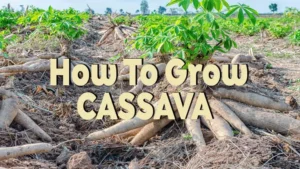











Leave your comment